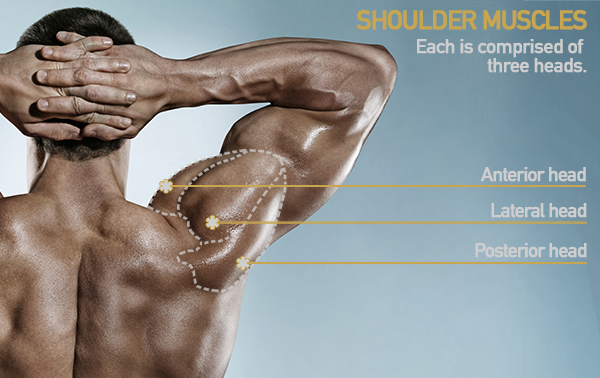What Is Shoulder Flexion?

Spend 5 minutes on the dance floor at a wedding, and you can’t help but notice that the shoulder is one of the most mobile parts of the human body.
Suddenly the funky chicken isn’t just a corny group dance — it’s a master class in the versatility of the ball-and-socket joint.
And raising the roof? That’s a real-life application of shoulder flexion.
What Is Shoulder Flexion?
“Shoulder flexion is when you pick your arms up and raise them overhead,” explains Cody Braun, NASM performance enhancement specialist.
It’s a movement that you probably perform throughout the day without even noticing.
Lifting a child, hailing a cab, and reaching for a can on the top shelf of your pantry — these are all examples of shoulder flexion.
This movement is also integral to most sports that utilize the upper body; every time a volleyball player bump passes or a power forward shoots a three-pointer, they’re using shoulder flexion.
Shoulder flexion vs. shoulder extension
But what goes up, must come down. The opposite of shoulder flexion is called shoulder extension.
“Think about bringing something down off of the top shelf,” Braun says. “If you grab an object in front of you and bring it closer to your body, you are using shoulder extension.”
Exercises That Use Shoulder Flexion
Since shoulder flexion is such a common, everyday movement, a well-rounded strength-training program should include shoulder flexion exercises.
1. Front shoulder raise
Appears in: 21 Day Fix >> Upper Fix
The front shoulder raise is a simple shoulder flexion exercise that can be scaled for beginners or more advanced athletes by adjusting the weight or level of resistance.
- Standing with your feet hip-width apart, hold a dumbbell in each hand with your arms at your side. (You can also use a resistance band by looping it under the arches of your feet.)
- Keeping your core engaged and your arms straight, raise your arms in front of you until your hands are shoulder height, palms facing each other.
- Pause, then slowly lower the dumbbells to the starting position and repeat.
2. Neutral-grip overhead shoulder press
This move not only strengthens the shoulder flexion muscles, but it can also help build bigger, more shapely shoulders.
Appears in: The Master’s Hammer and Chisel >> Hammer Power
- Stand with your feet shoulder-width apart. Hold two moderately heavy dumbbells at shoulder height with your palms facing each other.
- Press the weights overhead until your arms are straight. Keep your elbows tucked in close to your body.
- Lower the weights back to shoulder height and repeat.
Stretches for Shoulder Flexion Muscles
Stretching can help improve flexibility and help prevent injury. Incorporate these shoulder stretches into your cooldown following any workout that incorporates shoulder flexion exercises.
1. Hands-behind-the-back chest stretch
You’ll feel this simple but effective stretch in the deltoid and pectoralis major muscles.
Appears in: CORE DE FORCE >> MMA Shred
- Stand with your feet hip-width apart. Reach both hands behind your back and interlace your fingers.
- Looking up, raise your chest toward the ceiling as you pull your hands toward the floor and straighten your arms.
- Hold for 15 seconds and release.
2. Stability ball chest stretch
Don’t let the subtle movement of this chest and shoulder stretch fool you — the small contractions help loosen tight pecs and shoulders.
Appears in: P90X2 >> P.A.P. Upper
- Start on all fours with a stability ball placed to your right side. Lift your right arm to a 3 o’clock position and rest your palm on a stability ball.
- Slowly lower your body until you feel a stretch in the right side of your chest. Lift your fingers up and hold them up for one second. Then release your fingers down and repeat two more times.
- Repeat the sequence with the arm at the 2 o’clock position, then switch arms and repeat the entire sequence on the left side.
What Muscles Are Used in Shoulder Flexion?
The shoulder flexion muscles include the deltoid, the pectoralis major, and the coracobrachialis. The anterior head of the deltoid and the clavicular head of the pectoralis major are the prime movers for shoulder flexion, and the coracobrachialis is the synergist muscle, which means that it assists the prime movers. Here’s how these muscles work in your body.
Deltoid

The deltoid, the rounded, triangle-shaped muscle located on top of the shoulder, consists of three “heads,” or parts: the anterior (front) head, the lateral (middle) head, and the posterior (back) head.
These heads originate from the collarbone and shoulder blades and insert into the humerus (the upper arm bone).
While all three heads work together to move the arm, the anterior head is primarily responsible for shoulder flexion.
The lateral head moves the arm away from the body, and the posterior head is responsible for extension.
Pectoralis major

Commonly referred to as the “pecs,” the pectoralis major is the large, fan-shaped chest muscle that originates from the sternum and collarbone and inserts into the humerus.
In addition to playing a role in shoulder flexion, the pectoralis major functions to move the arm toward the body’s midline and to inwardly rotate the arm.
Coracobrachialis
Located on the upper, inner portion of the arm, the coracobrachialis is a small muscle that originates from the shoulder blade and inserts into the humerus.
The coracobrachialis’ main functions include assisting in shoulder flexion to raise the arms.
